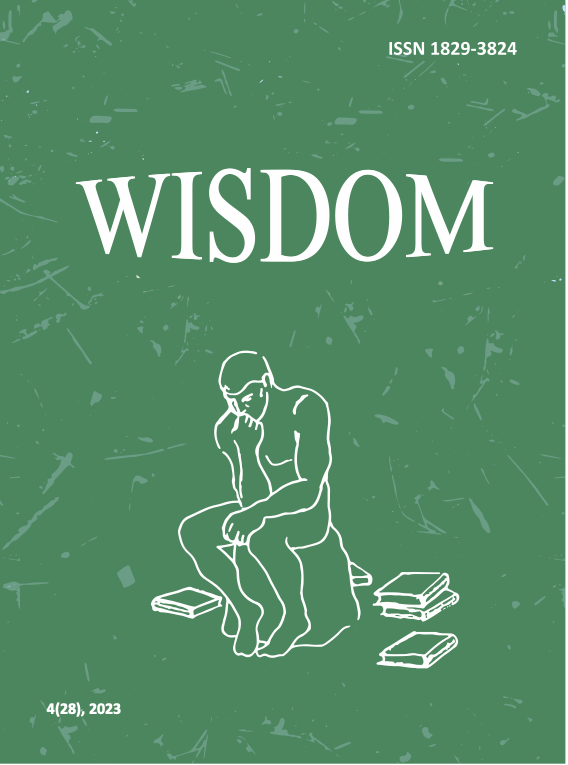The Main Theses of the Armenian Translation of the Definitions by Hermes Trismegistus
DOI:
https://doi.org/10.24234/wisdom.v7i2.147Keywords:
theologian, philosopher, Neo-Platonism, translation, Golden Age, scribe, international, value, orien-tal, HellenicAbstract
Academician Sen Arevshatyan, a great connoisseur of medieval philosophy, enumerates a series of philosophical and theological works, translated in the middle of the 5th century and the beginning of the 6th century, the texts of which have been preserved only in Armenian. Among them one shall cite seven works by Philo of Alexandria and the Definitions by Hermes Trismegistus.
The text of the Hermes’ work, which has an international value, was prepared to publication by academician Hacob Manandyan and it was printed in the journal “Banber Matenadarani” (“The Messenger of the Matenadaran”). To prepare the critical text of the work under study H. Manandyan has utilized six manuscripts kept in the Mashtots Matenadaran of Yerevan, the most ancient of which was written in the 13th century, before 1282.
The Definitions by Hermes Trismegistus were translated into Old Armenian at the second half of the 5th century. Translations made in that period from Greek and Hellenic works have deeply influenced Armenian authors of the Golden Age.
The careful study of this philosophical treaty shows numerous relations between this work and those of the Armenian authors of the 5th century and the following period.
The Armenian translation of Hermes Trismegistus’ work proves how much the scientific thought was developed in Armenia still in the 5th century. The fact of the translation of the Definitions by Hermes Trismegistus shows that in the 5th century Neo-Platonism was among the fundamental directions of Armenian philosophy and it is not fortuitous that David the Invincible became the greatest figure of this philosophical direction in Armenia
Downloads
References
Cucak d’er’agrac Mashtoci anvan Matenadarani (Catalogue of the Mashtots Matenadaran Manu-scripts, in Armenian), h. A. Yerevan.
Eghishe. (1989). Vardani & hayoc paterazmi masin (About the War of Vardan and the Armenians, in Armenian). T’argmanut’yuny’ & c’anot’agrut’yunnery’ (E. Ter-Minasyan Trans. into Modern Armenian and Annot.). Yerevan.
Koghbatsi, E. (1970). Eghc’ aghandoc (Refutation of the Sects, in Armenian). T’argmanut’yuny’ & c’anot’agrut’yunnery’ (A.A. Abrahamyan, Trans. into Modern Armenian and Annot.). Yerevan.
L’épée de Jean-Pierre Mahé (2002), Paris.
Mahé, J.-P. (1978). Hermès en Haute-Égypte. Québec.
Manandyan, H. (1956). Hermeay Er’amec’i ar’ Askghepios «Sahmanq» (Definitions of Hermes Trismegistus to Asclepius, in Armenian), Banber Matenadarani, No 3. Yerevan.
Mokatsi, N. (1975). Banasteghc’ut’yunner (Poems, in Armenian), (A.G. Dolukhanyan, Ed.). Yerevan.
Narekatsi, G. (1979). Matyan oghbergut’yan (Book of Lamentation, in Armenian). Yerevan.
Nouveau Dictionnaire de la Langue Arménienne (1836). vol. I. Venice.
Zarbhanalyan, G. (1889). Haykakan t’argmanut’iw’nq naxneac (IV-XIII darer) (Armenian Translations of Ancient Authors (5th – 13th centuries), in Armenian). Venice.
Downloads
Published
How to Cite
Issue
Section
License
Creative Commons Attribution-Non-Commercial (CC BY-NC). CC BY-NC allows users to copy and distribute the article, provided this is not done for commercial purposes. The users may adapt – remix, transform, and build upon the material giving appropriate credit, and providing a link to the license. The full details of the license are available at https://creativecommons.org/licenses/by-nc/4.0/.















